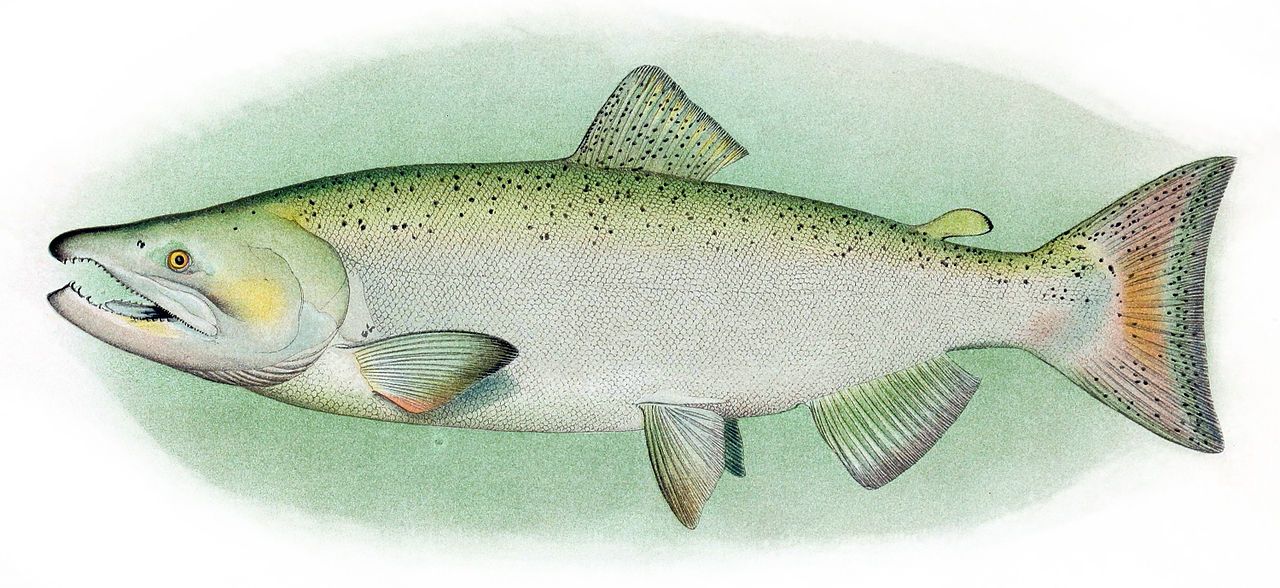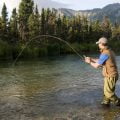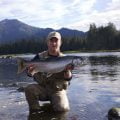As of August 3, 2014, the Sawtooth Fish Hatchery has seen 1,092 Chinook Salmon and 151 Sockeye Salmon, with 148 of the Sockeye actually caught in the Redfish Lake Creek trap. That’s exciting news!
Don’t miss your chance to see one of these amazing creatures following there incredible journey over the Longest Pacific Salmon Run in North America.
You’re probably familiar with store bought Salmon, but the Salmon referenced here are part of an endangered group which lives in the Snake River-Salmon River drainage. Due to dams, over-fishing, and other environmental impacts, we’ve seen the returning population dwindle over the last several decades. This culminated in 1996, when “Lonesome Larry” became the legendary, lone returning Salmon to Redfish Lake.
That sad story has been made positive over the years since 1985, when the Sawtooth Fish Hatchery was constructed as a starting point for recovery efforts, and 1991, when multi-agency and tribal efforts began a Captive Broodstock Program in order to begin rebuilding a healthy population of salmon in the region.
So, What’s A Salmon?
There are actually two varieties of salmon that return to Redfish Lake, and the Stanley area…
Sockeye Salmon – also called Red Salmon or Blueback Salmon, the adult Sockeye can grow to a size of 33 inches in length and up to 15 pounds in weight. These beautiful fish are the very reason Redfish Lake is so-named. The population was said to have been so abundant that you could walk over water  atop their backs.
atop their backs.
Once they arrive at Redfish Lake, females choose nesting sites, called redds, and produce 3-5 of them over the course of several days, while various male suitors fertilize their egg batches. After eggs hatch, the fish stay in the lake for 1 to 2 years, before swimming the long distance to the Pacific Ocean as smolts – juvenile fish. As they return to the lake, 2 to 3 years later, many of them show significant wounds and battle scars earned along the incredible 900 mile journey they’ve now undertaken twice in their life. The strength and stamina required for such a swim is astonishing.
Chinook Salmon – is the largest species of Salmon in the Pacific Ocean, growing to from 24-36 inches in length (or larger in some cases) and from 10 to 50 pounds in weight. They are also referred to as King Salmon or Quinnat Salmon, depending upon region. These fish tend to spawn in larger, deeper waters, such as Redfish Lake. After laying eggs, females spend between 4 and 25 days guarding their redds before dying. After 90 to 150 days, eggs hatch and young fish, called fries, are born. Fries spend 12 to 18 months in fresh water, growing through parr phase, and becoming smolts prior to returning to the Pacific Ocean, where they live an average of 3 to 4 years before returning to their birthing waters to spawn.
dying. After 90 to 150 days, eggs hatch and young fish, called fries, are born. Fries spend 12 to 18 months in fresh water, growing through parr phase, and becoming smolts prior to returning to the Pacific Ocean, where they live an average of 3 to 4 years before returning to their birthing waters to spawn.
Kokanee Salmon – is a species of land-locked Sockeye Salmon, which has developed slight genetic differences over time. Typically, they grow to their largest at around 14 inches. While they are free to catch for most of the summer, the fishing season for these handsome devils ends on August 7 – when spawning begins and they turn bright red, just like their bigger cousins.
Salmon are considered Anadromous – which means that most live in the ocean and return to freshwater to spawn, while some live in freshwater, returning to streams and rivers to spawn.
Now that you know more about them, here’s a list of 5 Great Places to See A Salmon or Kokanee. Read on and see what you can spot on your next visit.
Redfish Lake Creek
A great place to start looking for a Salmon is Redfish Lake Creek. Starting from the point where the creek empties into the Salmon River, curious visitors can explore the various small pools which sit beneath the rock formations that create the Creek’s steep cascades. This is an exceptionally difficult portion of the journey, but truly the final leg of an awesome display of natural power. Watch for the flashing red of the Sockeye Salmon as they gather strength to literally climb waterfalls from the river up to the Little Redfish Lake and eventually Redfish Lake itself. The bridge over the Creek, near the outlet of Little Redfish Lake, may also offer good viewing in its shallow, clear waters.
Fishhook Creek
You can find Kokanee spawning – in large numbers – in Fishhook Creek throughout August and into early September, making this an excellent time to wander the Visitor Center’s Fishhook Creek Nature Walk. The trail’s boardwalk, which stands on stilts above the creek, offers several wonderful vantage points for viewing the bright red fish from above. This is likely your best opportunity for a great close-up, with large groups clustered together in deeper pools, so keep your eyes peeled and camera ready.
Redfish Lake Creek Inlet (South End of Lake)
The best spot to see Salmon spawning beds is in the shallow, clear water near the southern end of Redfish Lake. Watchful eyes peering below the water’s surface can spot clean circles that have been churned about as females lay eggs and males fertilize the redds. Given the clear waters, it’s often very possible to see females guarding redds and males seeking mates. Early morning and evening tend to offer the calmest waters for viewing, as fewer boats and easier winds tend to impact the surface less.
Redfish Boat Launch (East Side of Lake)
The Sawtooth Fish Hatchery uses the Redfish Lake Boat Launch as a dropping point for raised and trapped salmon, introducing them to the Lake in order to proceed with their spawning or growth, and eventual death. This makes the area near the Boat Launch familiar territory for these newly introduced fish. Visitors may find them swimming near the shore lines and through the shallows along the eastern side of the lake as they make their way to better spawning territories near the Inlet at the Lake’s southern end.
Salmon River
The Salmon River gets its name from, well, Salmon – so you can only imagine that this might be a good place to spot one. This is definitely true; However, the deeper and rougher waters of the River make it a bit more difficult for viewing. Keep in mind that they’ve been swimming for over 900 miles to get here, so there’s a good chance they may be hiding behind a big rock or at the bottom of a large pool to gather strength where the water is moving slower and they don’t need to work as hard to swim upstream. Shallows which run across the width of the river are also great places to spot these large fish as they cruise over the rock beds below.
Sawtooth Fish Hatchery
For a guaranteed show, don’t miss a trip to the Sawtooth Fish Hatchery. These hard-workers have been pushing to conserve the areas fish population since 1985, and have made a significant rebound for the areas Salmon. On your visit, you’ll be offered an up-close experience with the variety of species the group is working to sustain and manage in the region’s water bodies. Visitors can see fish at various stages of growth and life and learn about Idaho’s natural history, while kids can enjoy free access to a fishing pond which is stocked regularly with trout. Kids love it!



